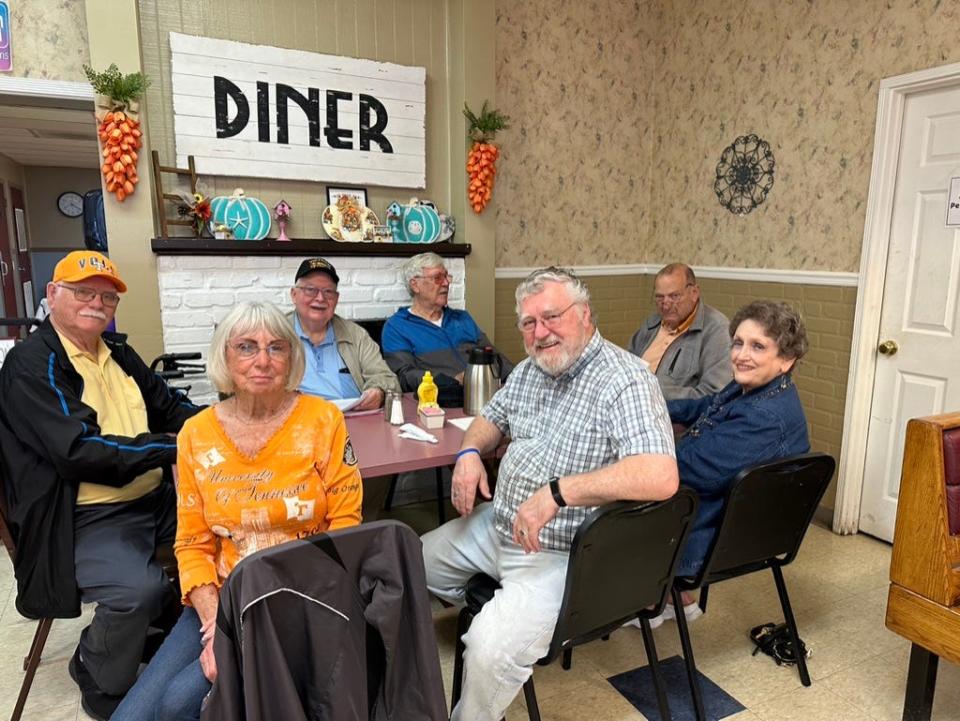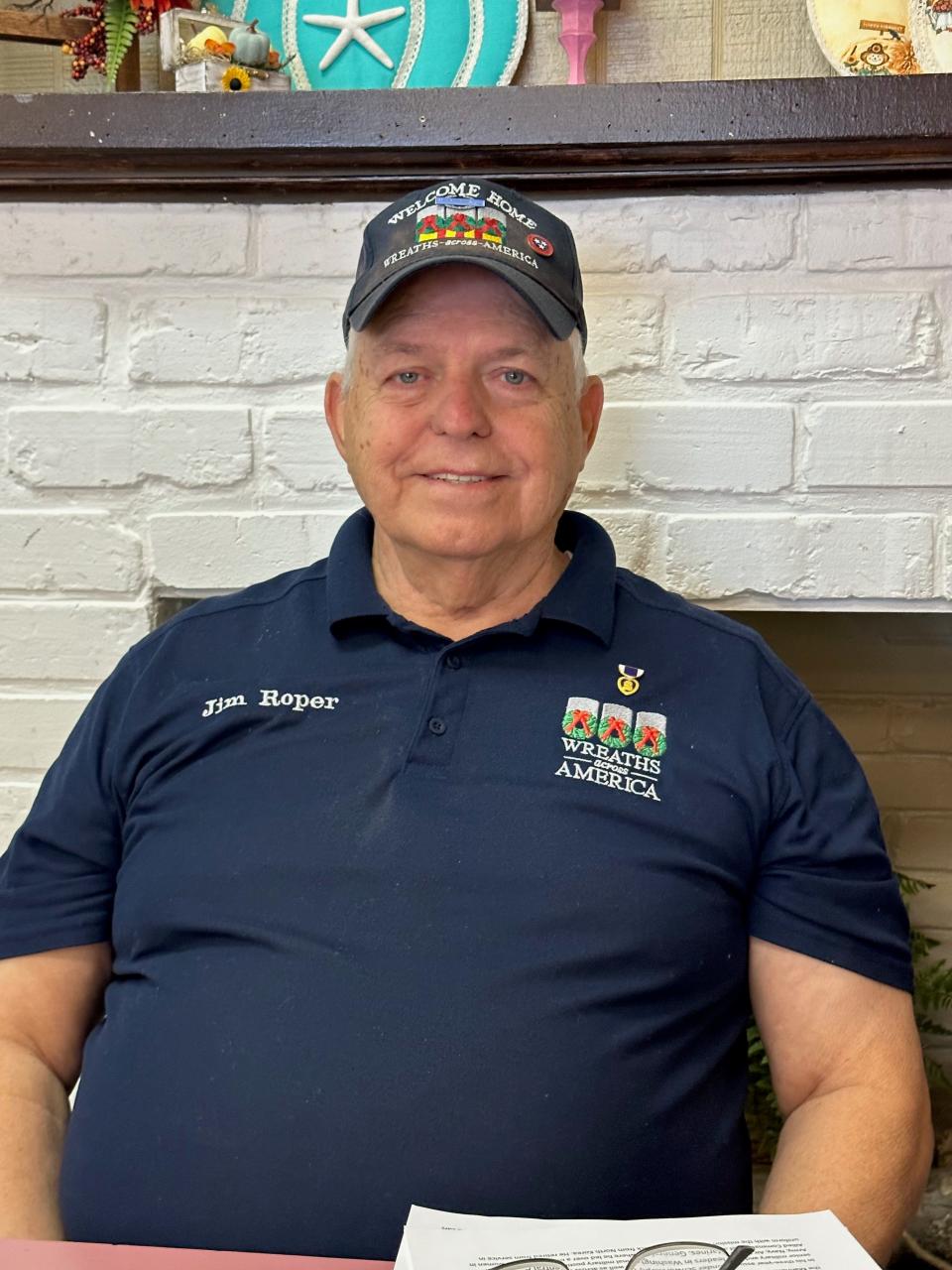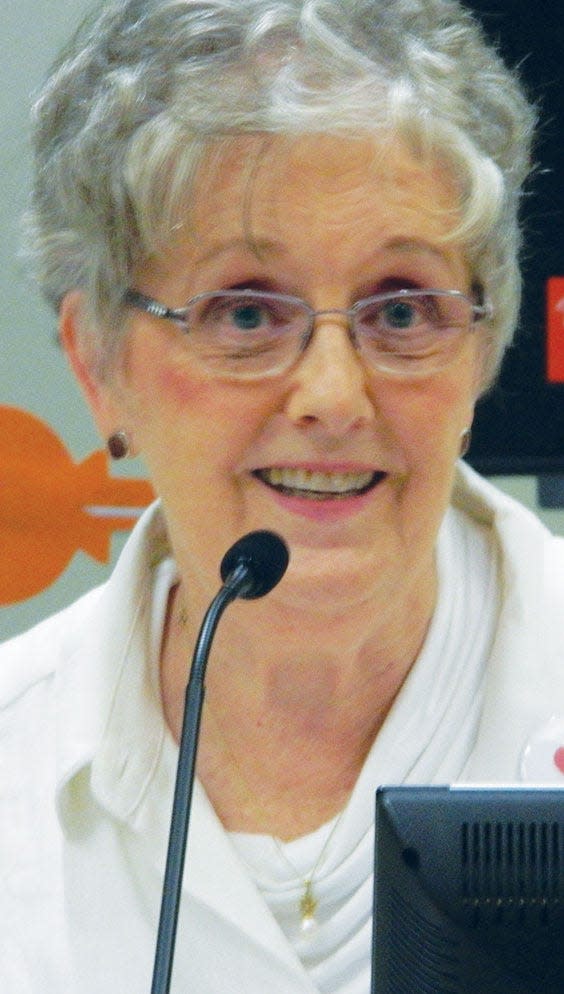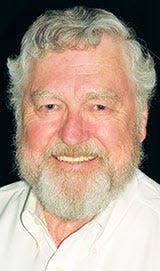Focusing on Oak Ridge's Vietnam War veterans, Part 2
- Oops!Something went wrong.Please try again later.
Benita Albert continues her insightful series into the experiences of four Vietnam veterans with Oak Ridge connections. You will be amazed at what she learned from them. Part One was published Tuesday and can be read online at oakridger.com.
***
The Vietnam War officially escalated with the Gulf of Tonkin Resolution passed by the U.S. Congress on Aug. 7, 1964. It gave then President Lyndon Johnson authority to take measures needed to repel any acts of aggression against the forces of the United States and to prevent further aggression.

In the early 1960s, the U.S. was involved in a limited conflict in South Vietnam with the goal of containing the spread of communism in southeast Asia. By 1968 more than one-half million U.S. men were on the ground in Vietnam. The human toll from 1964-1972 included 58,220 killed in action, over 150,000 wounded, and some 1,600 missing U.S. servicemen.
Though complete records of all the Oak Ridge High School alumni who served during Vietnam are not available, Oak Ridge, like most other towns across America, once again saw their young men leave for war in the 1960s and early 1970s. Part One of this story mentioned selected ORHS graduates who served in World War II and the Korean War.
Additionally, ORHS Class of 1965 alumnus and four-star General B.B. Bell’s career included serving as the executive assistant to Gen. Norman Schwarzkopf who planned and led Operations Desert Storm and Desert Shield. It is past time to tell the stories of Vietnam veterans from this area.
Tommy Ethridge
Tommy Ethridge (ORHS ’61) chose to enlist in the Air Force in February 1960. After basic training he was sent to technical training for flight refueling and became a Petroleum, Oil, and Lubricant Specialist. He subsequently received orders for Kadena Airbase on Okinawa.
Okinawa was a key staging point for the U.S. in the Asia-Pacific region. Kadena Airbase served as the Pentagon’s supply hub through which soldiers, weapons, and ammunition were routed; where missile defense systems were set at ready; and advanced anchorage was provided for allied fleets. During the Vietnam War, Kadena was one of the busiest bases on the planet.
Tommy’s assignment included refueling missions in KB-50 aircraft.
He said, “I never put my foot on the ground. I saw Vietnam from 32,000-34,000 feet above.”
KB-50s were rehabbed bombers that carried two large fuel tanks in the former bomb bay. American special forces were in Vietnam training the South Vietnamese army to defend itself against Viet Cong insurgencies in the early 1960s.
As a part of the Materials Air Command, Tommy was on standby daily to fly refueling missions over Laos, the Philippines, Japan, and Vietnam. His seat was on the port side of the plane, where he would lean out into a glass bubble to watch the approaching plane, unreel the refueling hose, ensure connection and pump fuel, then reel back the hose and secure it.
He was later assigned to Barksdale Air Force Base in Louisiana, joining the Strategic Air Command and flying in Boeing KC-135s as a refueler.
Tommy said, “We flew almost every day supporting fighters during the Cuban Missile Crisis. I also refueled U-2 reconnaissance planes.” He mustered out in 1964 from active duty.
After a series of jobs, Tommy pursued a degree in engineering from Georgia Tech that he completed in 1974. In 1976 his employer asked Tommy to set up an Oak Ridge headquarter for CH2MHill, a company providing utilities engineering services. After six years in Oak Ridge, Tommy accepted the position of superintendent of utilities for the town of Corbin, Kentucky in 1982 and followed that with a 10-year appointment as the maintenance superintendent in Public Works for the city of Oak Ridge, retiring in 2001.
Tommy is the father of three daughters. The two oldest, Tonya and Belinda, graduated from Clinton High School. His youngest, Shana, graduated from ORHS in 1988.
Should you see a 1975 Chevrolet Malibu Classic with butternut yellow paint and black vinyl top cruising the streets of Oak Ridge, you are seeing the latest in Tommy’s long list of classic autos he has restored and/or collected over many years. He rented a warehouse on Midway Lane, where he housed as many as 35 cars during the height of his collecting. He now claims that he has found his dream ride in his yellow Malibu, a step back in time and memory to a beloved green model he bought shortly after his Georgia Tech graduation.
Jimmy Luttrell
Drafted in May of 1965, Jimmy Luttrell (Knoxville Rule High School ’62) said that because he was an only son, the army would not send him into an active war zone. He was assigned to Kadena Airbase on Okinawa as part of the missile crew in January 1966.
He said, “When we were flown into Okinawa, the pilot tipped the plane for us to observe the island from 30,000 feet. It looked no bigger than a loaf of bread.” (The island is approximately 70 miles long and seven miles wide.)
Jimmy worked in an underground pad at the missile site that kept Nike Hercules missiles on alert. Though he did not see an actual combat use, he did observe the firing of obsolete missiles into the South China Sea. The Nike Hercules was considered state-of-the-art in defense technology and the most accurate artillery weapon in the Army’s arsenal at the time. An air defense program using PAC-3 (Patriot Advanced Capability) missiles is the current state-of-the-art U.S. missile defense system located on Okinawa.
Jimmy complained that the weather was hot and muggy.
He remembered, “One day I changed uniforms five times.” He continued, “Our compound was fenced in, and along with army security personnel, dog patrols were utilized.”
Jimmy returned to the States in May of ’67 and married Mary Kilgore (ORHS ’63) soon thereafter. Jimmy worked for the Gulf Oil Co. for 35 years before retiring. He also served as a Neyland Stadium usher for University of Tennessee football games for 35 seasons.
His move to Oak Ridge in 1967 converted him into a Wildcat fan in a town he describes as: “A great place to raise a family and to see my family graduate from ORHS: two daughters (Laura in ’86 and Kelly in ’89) and two grandchildren (Tyler and Alexis Vickery, ’09 and ’12, respectively). Mary said that Jimmy enjoys accompanying her to ‘63 ORHS class reunions and following ORHS football.
Rick Young
Rick Young attended the first two quarters at UT after his ORHS graduation in 1967. He then chose to drop out of college and work for a time, that decision soon resulting in an army draft letter. During basic training, his former ORHS football knee problems reemerged, and he realized that his future military work needed to be adjusted to his physical constraints. He chose to train as a cable splicer, a skill vital for maintaining secure military wire communication systems.
Rick shipped to Vietnam in 1969 for his duty assignment in Long Binh Post. This U.S. Army base functioned as a logistics center and major command headquarters. The base was nicknamed Long Binh Junction, a clever way of using the initials of the then President Lyndon Baines Johnson. Rick described it as the ‘South Vietnam Pentagon.’ He said, “It was the site of all the military brass, the generals in charge of the war.”
Highly secured as Long Binh was, Rick’s work was precariously situated in front of the bunkered generals’ headquarters. He experienced Viet Cong firings that mostly flew above him and his fellow splicers and which had little effect on the generals bunkered some 20 feet underground.
“At times it felt like we did more ducking than cable splicing,” Rick dryly observed.
After his Army discharge in 1970, Rick returned to Oak Ridge and had difficulty finding a job. He praised the actions of President Johnson who advocated for veterans, namely that they be supported via training programs and job placements. Rick was sent to Chattanooga to train with South Central Bell for a job very similar to his army cable splicing work.
After passing required tests for certification, Rick was delighted to be assigned in Oak Ridge where he would work for the next 30 years, 1972-2002.
Rick said, “I worked in all the Oak Ridge government plants. I even got to work with my dad, a crafts foreman at Y-12. My career included crawling though some strange access points, and even at times, through restricted spaces.”
Though Rick vowed to never marry, it was a blind date set up by his close friend, Ronnie LeTellier (ORHS ’67), that changed his bachelor thoughts after his return home from the service. Soon thereafter, Rick was married and the couple made their home in Oak Ridge. His wife and daughter, Christy Gail (ORHS ’96), are now deceased.
Rick’s parents moved their membership from the New York Avenue Church of Christ to help establish the Oak Ridge Church of Christ on North Purdue Avenue in the early 1950s. Rick’s family moved to a newly built cemesto house in Woodland, a rapidly developing neighborhood near their new church. Rick has been an active member of the church, excluding his Army assignment, for all years of the church’s existence. He is now the longest, faithfully serving member of the congregation.
Jim Roper

Jim Roper recalls receiving his draft notice, appearing for induction, and hearing the recruitment people requesting volunteers. They needed additional Marine recruits. When no one stepped up, the officials took it upon themselves to appoint every other recruit as a Marine or a soldier.
Jim said, “I got the Army and was sworn in on May 23, 1968.”
After advanced infantry training at Fort Ord, California, Jim was granted a 15-day leave and $40 in expense money. He did not have sufficient money to commercially transport himself home, so he hitchhiked part of the way.
Immediately after his leave, Jim shipped out for Vietnam on Jan. 2, 1969. He was assigned to the 4th Infantry Division and sent to Pleiku in the central highlands of South Vietnam. His company experienced several firefights, including one for which he received the Army Commendation Medal for Valor and the Purple Heart.
Jim related the harrowing confrontation: “We were headed back to base camp when ambushed on June 5, ’69. We thought we were passing through a friendly village. I was in the back when the front received fire. We set up a perimeter and returned fire. A mortar round from the enemy hit next to me and killed the soldier on one side while wounding the soldier on the other side of me. I was on my knees loading ammo belts when I saw the explosion coming and fell to the ground, perhaps saving my life.
“I was wounded and was placed on the first medical helicopter to go out. Since I was still conscious and could limp to the copter, I sat in the jump seat of the Huey where the gunner protected me. Five other seriously wounded soldiers were loaded on the open bay. Our copter subsequently received fire after lifting off the ground. Enemy mortar struck causing the copter to start losing fuel. We had to cripple to another landing site and transfer to a second rescue copter.
“I was transferred by medivac to a field hospital in Vietnam where they staunched my bleeding, then flown to Camp Zama in Japan for exploratory surgery in my abdomen. Eventually I was sent to Fort Campbell, the nearest base hospital, to Oak Ridge, where I received further medical care. It was during a 30-day convalescent leave here at home that my obvious pain convinced my mother to call my former pediatrician. Dr. Lewis Preston removed shrapnel from my leg that was trying to work out of my body. His in-office surgery greatly improved my mobility and pain.”
“I finished my military career at Fort Campbell, where I served as a fire arms instructor. During my naming ceremony to the rank of sergeant, I was awarded my war combat medals. I was discharged in May 1970 and returned to Oak Ridge.”
Jim was hired by the Department of Energy as a federal agent in security transportation, retiring in 2000. Jim is quite active in the local Vietnam Veterans of America, Chapter 1078. He proudly notes that it was this chapter that initiated the placement of 18,000 wreaths (as part of Wreaths Across America) and flags on Flag Day in local veterans’ cemeteries.
Jim was one of the charter members of the Oak Ridge Heritage & Preservation Association (ORHPA). He praised early ORHPA efforts to save the Alexander Inn/Guest House and the Wildcat Den. He volunteers two days a week at Providence House, a food pantry and clothing ministry. His daughter, Patricia, is an ORHS Class of ‘89 graduate.
***
We are indebted to these four men, and to the many others with Oak Ridge roots and beyond, who have served our country. So many young lives were put on hold, some never returned, many suffered physical and emotional trauma, and yet, they made the sacrifice.
Recently, I watched as a young boy, perhaps around age seven, got up from his breakfast table at Jefferson Fountain. He walked over to my Vietnam-era husband to say, “Thank you for your service.” My husband was deeply touched. Should that young man or his parents read this, please know that my husband will never forget, and will always treasure, his sincerely offered message.
Though my articles in “Historically Speaking” focus on stories of ORHS alumni in large part, I also want to thank D. Ray Smith, editor of this column, for his Vietnam service. The average age of a Vietnam vet is now 68. Of the 2,709,981 Americans who served in Vietnam, less than 850,000 are alive today.
In conclusion, I asked this story’s veterans to share how their military service shaped their lives.
Tommy Ethridge: “It taught me respect for others and for myself as well as dignity for all.”
Jimmy Luttrell: “It made me appreciate America, and the privileges we have, even more.”
Rick Young: “It gave me critical training skills that became my life’s work.”
Jim Roper: “It is difficult to put in words what it has meant to me.”
However, I note that Jim has dedicated endless energy and time to veterans causes, remembrances, and camaraderie. No doubt, his leadership example has strengthened and encouraged many in the veterans’ community.
Thank you, veterans, and “Welcome Home.”
***
Thank you, Benita! What a wonderful series you have created. I am sure the four Vietnam veterans are amazed at what you have done to capture the essence of their experiences.
I know I certainly appreciate the mention of my Vietnam service. I want to share something very personal with you readers:
Of all the travel in Europe that Fanny and I did after retirement, the visit to Normandy at the American Cemetery near Omaha Beach stands out as a most meaningful experience. After a ceremony where I helped lay a wreath at the base of the monument and other veterans were asked to join us there to be recognized as well, the man standing next to me looked at me and said simply, “Welcome Home.”
Now that is a dead giveaway that he is a Vietnam vet. We did not wear our uniforms when we returned and we certainly did not receive any welcome home. I responded by saying, “When were you in country?” He responded, “1968-69.” When he said that, immediately two other men standing next to us said at the same time, “I was there in 1968-69.” Time stood still for me! We did not talk as it was not necessary … we each knew what we had been through.
This only lasted a few seconds but Fanny was taking photos without knowing what was going on. When we got back to the ship that night, she showed me her photos and she had taken one of the four of us standing at the base of that monument. That is the highlight of all my European travels!


D. Ray Smith is the city of Oak Ridge historian and his "Historically Speaking" appears weekly in The Oak Ridger.
This article originally appeared on Oakridger: Focusing on Oak Ridge's Vietnam War veterans, Part 2

